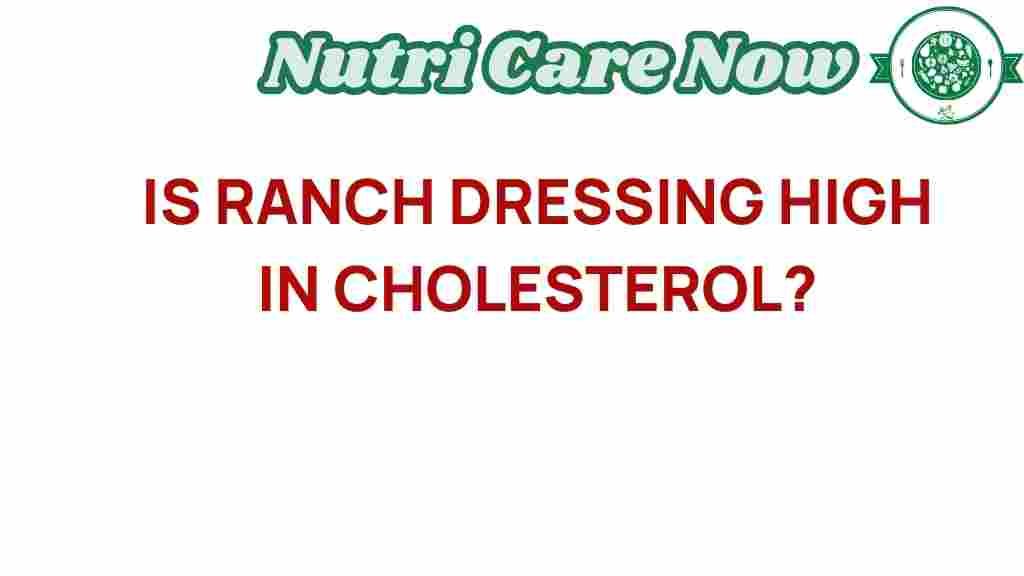Unpacking the Cholesterol Content of Ranch Dressing: What You Need to Know
Ranch dressing is one of the most popular condiments in the United States, often used as a salad dressing, dip, or flavor enhancer for various dishes. As people become increasingly health-conscious, understanding the cholesterol content of ranch dressing and its impact on heart health is crucial. In this article, we will explore the nutritional profile of ranch dressing, the role of dietary fats, health concerns related to its consumption, and how to make informed food choices regarding this beloved condiment.
Understanding the Ingredients of Ranch Dressing
To unpack the cholesterol content of ranch dressing, we first need to understand its ingredients. Traditional ranch dressing typically includes:
- Buttermilk: This is a fermented dairy product that contributes to the creamy texture and flavor.
- Mayonnaise: Made from eggs and oil, mayonnaise is a significant source of fat and cholesterol.
- Herbs and Spices: Common additions include garlic powder, onion powder, and dill, which enhance flavor without adding cholesterol.
- Vinegar and Lemon Juice: These ingredients add acidity and brightness to the dressing.
Nutritional Profile of Ranch Dressing
The nutritional content of ranch dressing can vary significantly depending on the brand and recipe. However, here is a general overview of the nutritional profile per two-tablespoon serving of traditional ranch dressing:
- Calories: Approximately 145
- Total Fat: 15g
- Saturated Fat: 2g
- Trans Fat: 0g
- Cholesterol: 15mg
- Sodium: 320mg
- Carbohydrates: 2g
- Protein: 1g
As we can see, ranch dressing contains a moderate amount of cholesterol, primarily due to its mayonnaise content. For those monitoring their dietary fats or cholesterol intake, this is an important consideration.
The Role of Dietary Fats in Ranch Dressing
Dietary fats play a crucial role in our nutrition, providing energy and supporting cell growth. However, not all fats are created equal. They can be classified into three main categories:
- Saturated Fats: Found in animal products like dairy and meat, excessive intake can raise LDL (bad) cholesterol levels.
- Unsaturated Fats: These are healthier fats found in plant-based oils and fatty fish, beneficial for heart health.
- Trans Fats: Often found in processed foods, these should be avoided as they increase the risk of heart disease.
Ranch dressing typically contains a mix of saturated and unsaturated fats, depending on the oil and dairy used. To make healthier choices, consider looking for brands that use healthier oils or low-fat buttermilk.
Health Concerns Related to Cholesterol and Ranch Dressing
Consuming foods high in cholesterol and saturated fats can raise concerns regarding heart health. Here are some critical points to consider:
Cholesterol and Heart Health
Research has shown that high cholesterol levels can lead to the development of heart disease. The American Heart Association recommends:
- Limiting saturated fat intake to less than 6% of total daily calories.
- Monitoring cholesterol intake to keep it under 300 mg per day for most individuals.
- Opting for unsaturated fats over saturated and trans fats.
When consuming ranch dressing, be mindful of your overall dietary fat and cholesterol intake for the day. If you enjoy ranch dressing, consider using it in moderation or opting for a lighter version that aligns better with your dietary goals.
Making Informed Food Choices
Being aware of the cholesterol content in ranch dressing can help you make better food choices. Here are some tips for incorporating ranch dressing into a balanced diet:
Tips for Enjoying Ranch Dressing Responsibly
- Portion Control: Use smaller amounts of ranch dressing to reduce calorie and fat intake.
- Homemade Options: Consider making your own ranch dressing using low-fat yogurt or avocado as a base for a healthier version.
- Pairing Wisely: Combine ranch dressing with fresh vegetables to create a nutritious snack or appetizer.
- Read Labels: Always check the nutrition label for fat and cholesterol content when purchasing store-bought ranch dressing.
By following these tips, you can still enjoy ranch dressing while being mindful of your health.
Frequently Asked Questions (FAQs)
1. Is ranch dressing bad for cholesterol?
Ranch dressing can be high in cholesterol and saturated fats, which may impact heart health if consumed excessively. Moderation and mindful choices are key.
2. Are there healthier alternatives to ranch dressing?
Yes! Healthier alternatives include yogurt-based dressings, vinaigrettes, and homemade versions using avocado or tahini.
3. How can I reduce cholesterol in my diet?
Focus on increasing your intake of fruits, vegetables, whole grains, and lean proteins while reducing saturated and trans fat consumption. Regular physical activity can also help manage cholesterol levels.
Conclusion
Ranch dressing is a popular condiment that can fit into a balanced diet when consumed mindfully. Understanding the cholesterol content, the role of dietary fats, and the potential health concerns associated with it can empower you to make better food choices. By being aware of your dietary awareness and considering healthier alternatives, you can enjoy ranch dressing without compromising your heart health.
For more information on maintaining a heart-healthy diet, visit the American Heart Association. To explore homemade ranch dressing recipes and healthier condiment options, check out our food choices guide.
This article is in the category Health and created by NutriCareNow Team
